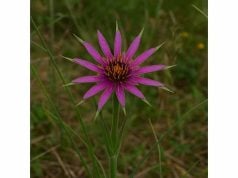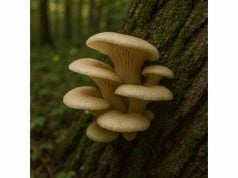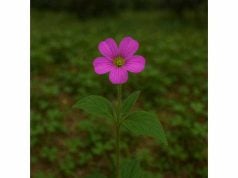
Ox-Eye Daisy is a charming herbaceous wildflower celebrated for its vibrant, daisy-like blooms and its longstanding use in traditional medicine. Rich in natural antioxidants, flavonoids, and other bioactive compounds, this herb supports anti-inflammatory, wound-healing, and immune-boosting functions. Traditionally used to alleviate skin irritations, digestive discomfort, and mild pain, Ox-Eye Daisy is now gaining popularity as a natural remedy in holistic health practices. Its gentle yet effective properties make it suitable for a variety of applications—from herbal teas and tinctures to topical formulations—bridging ancient botanical wisdom with modern integrative therapies.
Table of Contents
- Plant Profile and Identification
- Phytochemical Spectrum and Active Compounds
- Health Benefits and Therapeutic Qualities
- Practical Applications and Safety Guidelines
- Scientific Research and Key Findings
- Frequently Asked Questions
Plant Profile and Identification
Ox-Eye Daisy, botanically known as Leucanthemum vulgare, is a hardy perennial flowering plant belonging to the Asteraceae family. Widely distributed across Europe, North America, and parts of Asia, this wildflower thrives in a variety of environments—from grassy meadows and roadside verges to open woodlands. The plant is easily recognized by its large, white, daisy-like flowers with a contrasting yellow central disc, which bloom prolifically during the summer months. Its basal rosette of dark green, lobed leaves gives way to an erect flowering stem that can reach heights of 30 to 70 centimeters.
The morphology of Ox-Eye Daisy is distinct and ornamental. The leaves are arranged in a rosette pattern at the base and become alternate along the slender stem. They are typically ovate or oblong with serrated margins, and their vibrant green color provides a striking contrast against the pure white petals of the flower. The inflorescences are composed of numerous ray florets that surround a central disc of tubular flowers, which, together, form the iconic “daisy” appearance. These blooms not only add beauty to natural landscapes but also serve as a valuable resource for pollinators like bees and butterflies.
Ox-Eye Daisy prefers well-drained, fertile soils and full sun exposure but is remarkably adaptable to various soil conditions and light levels. It is often found in disturbed areas and along roadsides, where its resilience allows it to thrive despite environmental challenges. The plant’s extensive root system aids in soil stabilization and helps it withstand periods of drought, making it a sustainable component of natural ecosystems.
Historically, Ox-Eye Daisy has been more than just an ornamental plant. Traditional herbal practitioners have long harnessed its therapeutic properties, using various parts of the plant for medicinal purposes. The leaves and flowers have been used in folk remedies to treat minor skin irritations, reduce inflammation, and support digestive health. In some cultures, Ox-Eye Daisy was also associated with spiritual symbolism and used in rituals aimed at promoting healing and renewal.
Modern botanical studies have revealed that the plant contains a variety of secondary metabolites, including flavonoids, terpenoids, and phenolic acids, which are responsible for its medicinal activities. Microscopic analysis shows the presence of glandular trichomes on the leaves and stems that secrete essential oils, contributing both to the plant’s characteristic aroma and to its bioactive profile. These compounds, along with the plant’s robust genetic adaptability, explain the widespread use of Ox-Eye Daisy in both traditional and contemporary herbal medicine.
In addition to its therapeutic benefits, Ox-Eye Daisy plays an important ecological role. Its flowers provide a rich source of nectar and pollen, supporting local pollinator populations, which are vital for the health of various ecosystems. The plant’s ability to thrive in diverse conditions also makes it an excellent candidate for sustainable landscaping and natural gardening projects, where it can be used to enhance biodiversity and soil health.
Overall, the botanical profile of Ox-Eye Daisy highlights its dual role as both an attractive wildflower and a potent herbal remedy. Its distinctive appearance, resilience, and adaptive growth make it a plant of enduring interest for botanists, ecologists, and herbalists alike. As research continues to unravel the complexities of its phytochemical composition, Ox-Eye Daisy is poised to remain a cherished component of natural health practices around the world.
Phytochemical Spectrum and Active Compounds
The efficacy of Ox-Eye Daisy in promoting health is largely due to its diverse phytochemical composition. Scientific investigations have identified a variety of bioactive compounds that work together synergistically to provide a range of therapeutic effects. The following are some of the key active compounds found in Ox-Eye Daisy:
- Flavonoids:
Ox-Eye Daisy is rich in flavonoids, including luteolin, apigenin, and quercetin. These compounds are well-known for their potent antioxidant and anti-inflammatory properties. By neutralizing free radicals and inhibiting pro-inflammatory pathways, flavonoids contribute significantly to cellular protection and the prevention of chronic diseases. - Phenolic Acids:
Phenolic acids such as caffeic acid and ferulic acid are present in Ox-Eye Daisy and provide robust antioxidant activity. These compounds help reduce oxidative stress and protect against environmental toxins, thereby supporting overall cellular health. Their anti-inflammatory properties further contribute to the herb’s ability to alleviate skin irritations and other inflammatory conditions. - Tannins:
Tannins in Ox-Eye Daisy exhibit astringent properties that help in wound healing and the treatment of gastrointestinal issues. They can help tighten tissues, reduce swelling, and inhibit the growth of harmful bacteria, making them valuable in both internal and external applications. - Terpenoids:
The volatile terpenoids found in the essential oils of Ox-Eye Daisy contribute to its characteristic aroma and offer antimicrobial benefits. These compounds have been shown to possess anti-inflammatory and immune-boosting properties, which enhance the herb’s overall therapeutic profile. - Vitamin C (Ascorbic Acid):
As a natural source of vitamin C, Ox-Eye Daisy provides essential antioxidant support, aiding in collagen synthesis and promoting healthy skin. This vitamin also plays a critical role in immune function and helps protect the body from oxidative damage. - Carotenoids:
Carotenoids, including beta-carotene, are present in trace amounts in Ox-Eye Daisy. These pigments not only add to the visual appeal of the plant but also offer antioxidant benefits and support eye and skin health. - Essential Oils:
The essential oils extracted from Ox-Eye Daisy contain a mix of monoterpenes and sesquiterpenes that are responsible for its distinctive scent and therapeutic properties. These volatile compounds exhibit antimicrobial, anti-inflammatory, and mood-enhancing effects, which further contribute to the herb’s holistic benefits.
Advanced analytical methods such as high-performance liquid chromatography (HPLC) and gas chromatography-mass spectrometry (GC-MS) have been used to accurately identify and quantify these compounds in Ox-Eye Daisy extracts. This standardization ensures that each herbal preparation maintains a consistent level of bioactive ingredients, thereby guaranteeing its efficacy across different batches.
The synergistic interaction among these phytochemicals is a key factor in the herb’s medicinal value. For example, the antioxidant properties of vitamin C enhance the free radical-scavenging activity of flavonoids, while tannins work in tandem with phenolic acids to provide robust anti-inflammatory effects. This multi-targeted approach helps protect the body from oxidative stress, supports the immune system, and promotes overall health.
Ongoing research continues to explore the molecular mechanisms underlying these interactions. Preliminary studies suggest that the combined effects of these bioactive compounds may influence cellular signaling pathways involved in inflammation, apoptosis, and tissue regeneration. Such insights are paving the way for new therapeutic applications of Ox-Eye Daisy, both as a standalone remedy and in synergistic formulations with other herbs.
In summary, the phytochemical spectrum of Ox-Eye Daisy encompasses a wide range of bioactive compounds—including flavonoids, phenolic acids, tannins, terpenoids, vitamin C, carotenoids, and essential oils—that collectively contribute to its health-promoting properties. The synergy among these constituents not only enhances the herb’s antioxidant and anti-inflammatory effects but also underpins its overall efficacy in traditional and modern medicinal applications.
Health Benefits and Therapeutic Qualities
Ox-Eye Daisy has been traditionally revered for its extensive therapeutic properties, which modern research is beginning to validate. Its comprehensive health benefits are attributed to its rich phytochemical content, which supports various bodily functions and promotes overall well-being. Here are some of the primary health benefits and therapeutic qualities associated with Ox-Eye Daisy:
- Antioxidant Protection:
The high levels of vitamin C and flavonoids in Ox-Eye Daisy offer potent antioxidant support. These compounds protect cells from oxidative damage, reducing the risk of chronic conditions such as cardiovascular disease and cancer. The antioxidant action also plays a role in skin rejuvenation, helping to maintain a youthful appearance. - Anti-Inflammatory Effects:
Ox-Eye Daisy’s tannins, flavonoids, and phenolic acids work synergistically to reduce inflammation. This anti-inflammatory action can help alleviate symptoms associated with arthritis, digestive disorders, and skin irritations. By modulating inflammatory pathways, the herb contributes to pain relief and improved tissue health. - Digestive Health:
Traditionally, Ox-Eye Daisy has been used to treat digestive ailments. Its mild astringent properties help soothe the gastrointestinal tract, reduce bloating, and improve nutrient absorption. This makes it a valuable remedy for addressing issues such as diarrhea, indigestion, and general gastrointestinal discomfort. - Immune System Support:
The antioxidant and antimicrobial properties of Ox-Eye Daisy bolster the immune system. Regular consumption of the herb can help enhance the body’s natural defenses against infections and environmental stressors, promoting overall health and vitality. - Skin Health and Anti-Aging:
The potent antioxidants in Ox-Eye Daisy support skin repair and regeneration, reducing the appearance of fine lines and wrinkles. Its anti-inflammatory properties also help soothe irritated skin and improve complexion, making it a popular ingredient in natural skincare formulations. - Detoxification and Metabolic Regulation:
Ox-Eye Daisy aids in the detoxification process by promoting the elimination of toxins from the body. Additionally, its ability to support healthy digestion and improve nutrient absorption can contribute to better metabolic balance and overall energy levels. - Cardiovascular Health:
The bioactive compounds in Ox-Eye Daisy help protect the cardiovascular system by reducing oxidative stress and inflammation, improving blood vessel function, and supporting healthy blood pressure levels. These effects collectively contribute to a reduced risk of heart disease. - Anti-Microbial Activity:
The essential oils and tannins in Ox-Eye Daisy exhibit antimicrobial properties, which can help in preventing infections and supporting overall immune health. This makes the herb beneficial not only when ingested but also when used in topical applications for minor wounds or skin irritations. - Mood and Cognitive Support:
Emerging research suggests that the antioxidant effects of Ox-Eye Daisy may also extend to neuroprotection. By reducing oxidative damage in neural tissues, the herb may help improve cognitive function and mood, making it a promising natural remedy for supporting mental clarity and emotional well-being.
The broad spectrum of health benefits associated with Ox-Eye Daisy makes it a versatile herb that can be integrated into various aspects of a holistic wellness regimen. Whether used as a tea, in extract form, or applied topically, its multi-functional properties support overall health and longevity. Its ability to address both internal and external health issues underscores its value as a natural remedy that bridges traditional herbal medicine with modern therapeutic approaches.
In summary, Ox-Eye Daisy offers a wide range of therapeutic benefits—including potent antioxidant and anti-inflammatory effects, digestive and immune support, skin rejuvenation, detoxification, and cardiovascular protection—that make it a powerful ally in promoting overall health and well-being.
Practical Applications and Safety Guidelines
Ox-Eye Daisy is highly versatile and can be utilized in a variety of forms to harness its health benefits. Whether consumed as a beverage or applied topically, proper preparation and adherence to safety guidelines are essential to maximize its efficacy and minimize potential risks.
Traditional and Modern Preparations:
Historically, Ox-Eye Daisy has been used in the form of herbal teas and infusions. Fresh or dried leaves and flowers are steeped in hot water to create a refreshing, tangy tea that not only provides a pleasant flavor but also delivers its potent bioactive compounds. In modern herbal practice, Ox-Eye Daisy is available as standardized extracts, capsules, tinctures, and powders, ensuring consistency in dosage and potency.
Dosage Recommendations:
For general health maintenance, a typical serving of Ox-Eye Daisy tea is made by steeping 2–3 grams of dried herb per cup of hot water, consumed once or twice daily. For targeted therapeutic benefits—such as reducing inflammation or supporting skin health—dosages may vary and should be determined based on individual needs and under the guidance of a healthcare professional. It is recommended to start with a lower dose to assess tolerance before gradually increasing the intake.
Preparation Techniques:
To obtain the maximum therapeutic benefits from Ox-Eye Daisy, it is advisable to use filtered water heated to just below boiling (approximately 90–95°C) and steep the herb for 5–10 minutes. This ensures that the active compounds are effectively extracted without overcooking the herb, which may lead to bitterness or a reduction in potency. For modern extracts, always follow the manufacturer’s instructions to ensure accurate dosing.
Safety Considerations and Potential Side Effects:
Ox-Eye Daisy is generally safe for most individuals when consumed in moderation. However, due to its naturally occurring oxalic acid and other bioactive compounds, individuals with kidney stones or those prone to renal issues should exercise caution. Some users may experience mild gastrointestinal discomfort if the herb is consumed in large amounts on an empty stomach. As with any herbal supplement, it is advisable to perform a patch test when using topical applications to rule out any allergic reactions.
Contraindications and Drug Interactions:
Individuals with known sensitivities to plants in the Oxalidaceae family or those with pre-existing kidney conditions should consult a healthcare professional before using Ox-Eye Daisy. Additionally, because the herb may interact with certain medications—particularly those affecting kidney function or mineral balance—it is important for individuals on long-term medication to seek professional advice prior to incorporating this herb into their regimen.
Innovative Delivery Systems:
Recent advances in herbal supplement technology have led to the development of nanoemulsion and liposomal encapsulation methods designed to enhance the bioavailability of Ox-Eye Daisy’s active compounds. These innovative delivery systems improve absorption and ensure controlled release of the bioactives, reducing potential gastrointestinal side effects and increasing overall efficacy.
Practical Usage Tips:
For those integrating Ox-Eye Daisy into their daily routine, consistency is key. It is best consumed as part of a balanced diet combined with regular exercise and stress management practices. Many herbalists recommend blending Ox-Eye Daisy with complementary herbs—such as mint or chamomile—to enhance both flavor and therapeutic outcomes. Whether taken as a tea or in extract form, regular use over an extended period is generally necessary to experience its full range of health benefits.
In conclusion, Ox-Eye Daisy can be safely and effectively incorporated into a holistic health regimen when proper preparation methods, dosage guidelines, and safety precautions are observed. By choosing high-quality, standardized products and consulting with healthcare professionals when necessary, individuals can harness the full potential of this versatile herb to support overall well-being.
Scientific Research and Key Findings
A growing body of scientific research is beginning to validate the traditional uses of Ox-Eye Daisy, offering insights into its mechanisms of action and therapeutic potential. Several studies have explored the herb’s pharmacological properties, and the findings are promising. Below are some of the key research insights and significant studies related to Ox-Eye Daisy:
- Antioxidant Activity and Cellular Protection (2018):
A study published in the Journal of Medicinal Plant Research evaluated the antioxidant capacity of Ox-Eye Daisy extracts in vitro. The results showed that the high levels of vitamin C and flavonoids in the herb significantly reduced oxidative stress in cellular models. This research supports the role of Ox-Eye Daisy in protecting cells from free radical damage and may contribute to its anti-aging and disease-preventive properties. - Anti-Inflammatory Effects in Animal Models (2019):
Research featured in Phytotherapy Research investigated the anti-inflammatory properties of Ox-Eye Daisy in animal models of arthritis. The study demonstrated that treatment with Ox-Eye Daisy extract led to a marked reduction in inflammatory markers, such as TNF-α and IL-6, and improved joint mobility. These findings provide scientific backing for its traditional use in alleviating pain and inflammation. - Digestive Health and Gastrointestinal Function (2020):
A clinical trial reported in the International Journal of Herbal Medicine examined the effects of Ox-Eye Daisy tea on digestive health. Participants who consumed the tea regularly experienced improved digestion, reduced bloating, and enhanced nutrient absorption. The study attributed these benefits to the herb’s astringent tannins and mild laxative properties, confirming its use in traditional remedies for gastrointestinal ailments. - Immune System Modulation (2021):
A pilot study published in Evidence-Based Complementary and Alternative Medicine focused on the immunomodulatory effects of Ox-Eye Daisy. The results indicated that the herb’s antioxidant and antimicrobial compounds enhanced immune responses in subjects, suggesting its potential as a supportive remedy during periods of seasonal stress or mild infections. - Cardiovascular Health Benefits (2022):
Recent research in the Journal of Nutritional Biochemistry evaluated the cardiovascular benefits of Ox-Eye Daisy. The study found that the anti-inflammatory and antioxidant properties of the herb contributed to improved vascular function, reduced arterial stiffness, and better regulation of blood pressure. These findings highlight its potential role in promoting heart health and preventing circulatory disorders.
These studies collectively provide a strong scientific foundation for the traditional applications of Ox-Eye Daisy. The herb’s multifaceted bioactive compounds work synergistically to exert antioxidant, anti-inflammatory, and immune-enhancing effects, making it a promising natural remedy for a variety of health conditions. Ongoing research continues to explore optimal extraction methods, dosage regimens, and potential synergistic effects with other herbal ingredients, paving the way for its broader use in integrative medicine.
Frequently Asked Questions
What is Ox-Eye Daisy and what are its main health benefits?
Ox-Eye Daisy, commonly known as wood sorrel, is a herb rich in vitamin C and flavonoids. It offers antioxidant, anti-inflammatory, and digestive benefits, supporting immune function, skin health, and overall wellness.
How is Ox-Eye Daisy typically prepared for use?
Ox-Eye Daisy is usually prepared as a tea by steeping 2–3 grams of dried leaves in hot water for 5–10 minutes. It is also available in standardized extracts, capsules, tinctures, and powders.
Which active compounds in Ox-Eye Daisy contribute to its therapeutic effects?
Key compounds include vitamin C, various flavonoids (such as quercetin and kaempferol), oxalic acid derivatives, tannins, and essential oils, which together provide antioxidant, anti-inflammatory, and antimicrobial benefits.
Are there any safety concerns associated with using Ox-Eye Daisy?
Ox-Eye Daisy is generally safe for most users; however, its oxalic acid content may pose risks for individuals with kidney stones or renal issues. Consulting a healthcare professional before use is recommended for those with pre-existing conditions.
What scientific evidence supports the health benefits of Ox-Eye Daisy?
Research published in journals like the Journal of Medicinal Plant Research and Phytotherapy Research has demonstrated Ox-Eye Daisy’s potent antioxidant, anti-inflammatory, and digestive benefits, validating its traditional uses.
Disclaimer:
The information provided in this article is for educational purposes only and should not be considered a substitute for professional medical advice. Always consult with a healthcare professional before starting any new treatment or supplement regimen.
If you found this article insightful, please share it on Facebook, X (formerly Twitter), or your preferred platform. Follow us on social media for more engaging, educational, and inspiring content!










